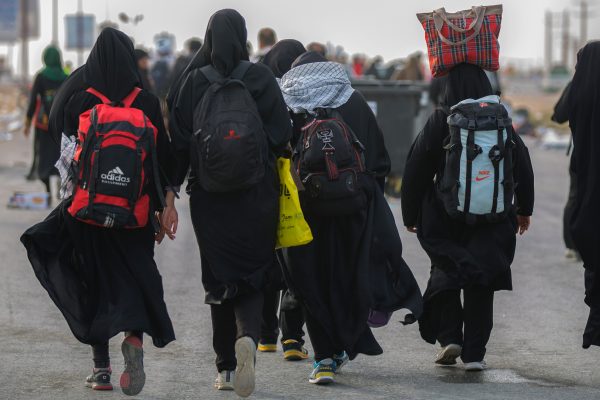In this intervention I argue that charitable or humanitarian practices among contemporary Muslims— and everyday religiosity more generally—are constituted and experienced not only through differences and contestations between different Islamic traditions/theologies, but also as the outcome of engagements and encounters with non-Muslim Others, whether religious, ethnic, secular or political, both locally and globally. Drawing inspiration from critical culture theory, and responding to the late Shahab Ahmed’s call for an expansive and open-ended exploration of historical practices of meaning-making within Islam, I propose an understanding of Muslim charitable and humanitarian practices located at the interstices of the routinized practices of the everyday and the inevitably open-ended fluidity of daily life.
In late August 2018, the state of Kerala on the south-west shores of India was ravaged by strong monsoon storms, resulting in extensive floods, destruction of houses and infrastructures, and more than 400 deaths due to landslides or drowning in flood waters up to 15 feet high. In the midst of such a catastrophic event, the local population started spontaneously the rescue and relief efforts, well before the eventual arrival of the state’s rescue services. During the following days, whilst the sizeable Keralite diaspora begun to pour cash into the Chief Minister Flood Relief Fund, the media reported countless instances of individual heroism and humanitarian generosity, from fishers taking inland their flat-bottomed outboard power boats to the rescue of more than 25,000 stranded villagers, to Hindu temples, Muslim mosques and Christian churches opening their doors to offer shelter and a place of worship to fellow villagers or neighbours of a different faith.
At the forefront of this ostensibly popular mobilization in the face of disaster stood Kerala youths, such as college and university students who made up a substantial percentage of the volunteers who responded to the call of political, religious and social organizations to join in a three-days long cleaning of mud-filled houses in the paddy-growing area of Kuttanad in southern Kerala.
Celebrated in the media as the expression of a regained deep-rooted tradition of communal harmony, pluralism and popular participation, such a rhetoric of amity and tolerance might contain a degree of wishful thinking.
Whilst faith-based organizations and charities were routinely accused of favouring their own community, across Kuttanad one could see the placards and flags of various youth organizations. From the Communist Democratic Youth Federation of India (DYFI) and the Student Federation of India (SFI), to the RSS-affiliated Akhil Bharatiya Vidyarthi Parishad (ABVP), the Jamaat-e-Islami’s Students Islamic Organisation of India (SIO) and the Sunni Students’ Federation (SSF) these organizations participated in the relief efforts, and amity and tensions between activists from these different groups surfaced with equal ease.
The state of Kerala is normally seen to have remained sheltered from the waves of communal violence which in the last 30 years have accompanied the radicalization of Indian politics along ethico-religious line. However, in recent years Kerala publics have been interrogating themselves on the shape and direction of everyday inter-community relations in the face of an apparent erosion of a historical “tradition” of communal tolerance. Underpinned by ideals of secular modernity and progressive politics this “tradition” has been the state’s hallmark since independence. These debates have multiple sources and shades, embedded as they are in the social position and political inclinations of various publics and counterpublics animating a state whose Hindu majority population lives alongside substantial Christian and Muslim communities – respectively approximately 18% and 27% – whose roots stretch back to the beginning of Christianity and Islam in West Asia. These ethnic-religious communities are heterogeneous and contingent social formations – internally fragmented into (formerly largely endogamous) hierarchically related status groups, shot through by a complex configuration of religious affiliations, class positions, overlapping political allegiances and local histories. Their self-awareness as exclusive “communities” took novel and specific connotations at the interstices of wider transformations engendered by Portuguese conquest, British colonialism, early 20th century socio-religious reformism, and post-independence nationalist developmentalism.
It is this complex historical entanglement between communities-in-the-making, local, trans-local and global religious networks which has constituted the historical terrain for the making of Kerala Muslims’ modalities of religiosity and which has shaped their status as “Muslims” in Kerala and in the framework of global modernity.
In this context, humanitarian practices, and everyday religiosity among contemporary Muslims are constituted and experienced not only through differences and contestations between different Islamic traditions, but are also the outcome of engagements and encounters with non-Muslim Others, whether religious, ethnic, secular or political, both locally and globally. In arguing so, I am taking issue with two trends in the study of religiosity/religion within and beyond anthropology which have overdetermined discussions about Islamic charity and humanitarianism.
The first has gathered strength on the back of Giorgio Agamben’s attempts in the Homo Sacer project to sketch a history of (western and modern) biopolitics via a genealogy of Christian theology and sacred history. Indeed, Agamben’s encyclopaedic work has stimulated a renewed interest in the theo-politics and theo-economics ostensibly underpinning the history and institutions of Western modernity (state, government and market). I have in mind a body of excellent studies, such as Dotan Leshem’s (2016) The Origins of Neoliberalism (2016), Devin Singh’s (2018) Divine Currency, Elettra Stimilli’s (2016) The Debt of the Living and the more recent Debt and Guilt (2018), as well as the 2017 translation in French (with an introduction of Thomas Piketty) of Giacomo Todeschini’s I mercanti e il tempio” (Les Marchands et le Temple 2017).
These studies explore ways through which economic language and categories of classical thought were taken up in early Christianity as the basis of a new theology. This, in turn, provided Church and Christian sovereigns with the means to develop a conceptual and practical apparatus – a dispositif, in Foucault’s terms – for economic and state administration, thus setting the basis for modern (and ostensibly secular) economic or political thought and practice. This extremely stimulating body of work not only emphasises the centrality of religious charity in the constitution of medieval or early modern economies and polities, but also underscores continuities between Christian charity, modern humanitarianism and state welfarism. However, rich as it is in theological insights, this body of work lacks of historical subjects: who are the subjects of the state in such a theo-politics, or the economic subjects of these theo-economics, we might ask? The institutions and practices of Western modernity emerge as an epiphenomenon of a subject-less theology.
Yet equally troubling to me is that this is a self-referential theology, solely focused on (European) Christianity, utterly impermeable to the historical circulation of ideas and practices across different polities and continents engendered, for instance, by trade, conquest or colonialism.
More generally, such an implausible parthenogenetic understanding of theology has allowed many scholars (in anthropology and beyond) to focus single-handedly on one religious tradition or another, with such traditions improbably represented as deriving from self-contained theologies (e.g. the much cited work of Saba Mahmood, and of those who have followed in her steps).

Photo by Utsman Media on Unsplash
The second target of my critique are those scholars who, by rejecting the privileged position often ascribed to scholarly/scriptural religion, replace the fetishism of theology with an equally improbable fetishism of practice. Predictably, this approach has had a degree of popularity in anthropology, a discipline traditionally preoccupied with the performativity of the everyday. And yet it received a substantial boost in recent years through the work of the historian Robert Orsi and his followers. Concerned “with what people do with religious idioms, how they use them, what they make of themselves and their worlds with them” (Orsi 2002: 172), he deploys the notion of “lived religion or everyday religion” to understand how religiosity and spirituality are experienced and expressed by ordinary people in the context of their daily lives. Here religion and religiosity have meaning only in relation to how people actually live, the domain of actual experiences of religious subjects which is distinguished from the prescribed religion of institutionally-defined beliefs and practices (see also McGuire 2008; Sullivan 2012). The latter, with their theologies and institutions, are thought as a fetter to the expression of popular religiosity which, instead, emerges from and speaks to deep-rooted embodied cultural orientations. The ghost of Geertz’s “religion as culture” is obvious in Orsi’s theorization of “everyday or lived religion”, and as such it resonates with many an anthropological study of religiosity in post-colonial context. Popular religiosity is normally endowed with the power to subvert the doctrinal boundaries of organized religion, enmeshed in an economy of affects ostensibly shared across social bodies, as in Anand Taneja’s recent ethnography of encounters with jinns in Old Delhi (2017), or Erica Bornstein’s (2012) study of everyday humanitarianism in the same city.
We are also told by anthropologists like Susan Bayly and David Mosse, or sociologist of religion such as Caroline Dempsey and Selva Raj that popular Islam and Christianity in South India – the cult of Christian and Muslim saints, in particular – are necessarily localized and hybrid in that they are embedded in culturally-specific orientations. Unsurprisingly, then, we find that in South Asia as elsewhere, much ethnographic work on everyday Muslim religiosity focuses on sufi-inspired forms of Islam, celebrating them as tolerant, plural, and authentic, against a much maligned Other of salafist Islam (for a critique, see Osella and Osella 2008). The latter is understood to embody practices which are either alien to the majority of South Asian Muslims, or altogether external to South Asian traditions, regarded as a threat to what are argued to be culturally specific forms of South Asian popular Islam. A recurrent theme in these studies is a putative opposition between sufism’s syncretism or hybridity, or what is more generally claimed as sufism’s cultural sensitivity and pluralism positioned against what are characterized as the essentialist and dogmatic logics of so-called scripturalist Islam. Such a Manichean approach explores connections between different religious traditions by recovering a demotic, almost spontaneous religiosity, but also naïvely conjures up a representation of “popular Islam” in which the latter exists and reproduces itself via devotional practices and traditions bereft of theological underpinnings.
To move beyond the analytical inadequacies of the fetishism of theology and the fetishism of practice, I suggest drawing on critical culture theory to gain a different understanding of everyday religion which locates religiosity within the wider—and thus political and contested—field of cultural production.
I propose an understanding of “everyday lived religion” which neither resuscitates improbable oppositions between textual Islam and popular religiosity, nor attributes authenticity and legitimacy to different or competing traditions of Islamic orthopraxis, but develops an analytics of their coming to being via intersectional exchanges and practices.
Drawing inspiration from Henry Lefebvre’s (1988) critique of the everyday, and responding to the late Shahab Ahmed’s (2016) call for an expansive and open-ended exploration of historical practices of meaning-making within Islam, I locate “lived religion” at the interstices of the routinized practices of the everyday. This entails a focus on the embodiment of specific dispositions via habituation, the deployment of technologies of self-crafting, and the inevitably open-ended fluidity of daily life. Thus, on the one hand, lived religion can be conceptualized as the discursive (and contested) terrain of moral reasoning whereby multiple and inchoate ways of sensing, knowing, being and doing might be shaped as commonsense (Gramsci 1997), acquiring coherence and substance through the performative effects of the cumulative interventions of a heterogeneous assemblage of (human and non-human) actors. On the other hand, if the banalization of Islam as “familiar, unquestioned, everyday religious practice” (Harriss et al. 2017: 18) whether in Kerala or elsewhere might underscore the emergence of quasi-hegemonic modalities of religiosity, the notion of lived religiosity also reveals what Williams (1977: 121) calls the residual and emergent, i.e. “the complex interrelations between movements and tendencies both within and beyond a specific and effective dominance.”

Photo by mostafa meraji on Unsplash
I do not wish to reduce “religion” to “culture”, but find it important to draw from critical cultural theory to conceptualize residual and emergent forms of religiosity as simultaneously contained within (and thus constitutive of) hegemonic or dominant modalities of religiosity. At the same time, they exceed the latter both as traces of multiple (“religious” and “secular”) discursive traditions, and as expressive of “new meanings and values, new practices, new relationships and kinds of relationships [which] are continually created” (Williams 125; see also Ahmed 2016). The notion of lived religion points us towards appreciating the historical and contemporary circulation of practices, aesthetics and theologies not only within and between religious traditions, but also across different social fields, as explored with great success in Soares and Marsden’s ethnographies. Instead of attempting to establish lines of causation between social fields, I want to stress—in time-honoured anthropological fashion—the contingent historical milieus in which particular modalities of moral reasoning develop. At the current historical juncture in which transformations of Islamic religious practice continue to be represented and misread—in academic writings and popular discourse as much as in the imagination of Muslims and non-Muslims alike— as determined primarily by theological debates or textual traditions, it is increasingly important, and indeed urgent to trace the articulation of Islamic discursive traditions within the broader social, cultural, political and economic environments in which they are debated and gain wider plausibility. This, in turn, should open the way to explore also the orientations and practices of those Muslims who imagine their ethical lives alongside or outside the confines of Islamic orthodoxy and who participate to the constitution of Muslim publics and identities, but whose voices, as Shahab Ahmed has argued, have been obscured in much contemporary studies of Muslim societies.
To conclude, then, I would argue that by focusing on the contingent and necessarily open-ended production of the everyday, we can appreciate the emergence of (novel) subjectivities which remain always incomplete and in the process of becoming. From this perspective, it might be unsurprising that Kerala’s Muslim youths can be simultaneously at the forefront of fashion and radical political activism, or can participate with equal vigour to ethics of piety or those of secular humanitarianism. They can claim both their particularity as Muslims, or participate in the making of contemporary Kerala youth cultures at large.
In other words, rather than positing somewhat fixed Muslim or Islamic identities and subjectivities, the focus is on historical processes of becoming Muslim in all their complexities, tensions and contradictions.
References
Ahmed, S., 2016. What is Islam?: The importance of being Islamic. Princeton: Princeton University Press.
Bornstein, E., 2012. Disquieting gifts: humanitarianism in New Delhi. Stanford: Stanford University Press.
Gramsci, A. 1997, La religione come senso comune. Milano: EST.
Harriss, J. C. Jeffrey, and S. Corbridge. 2017. Is India becoming the ‘Hindu Rashtra’ sought by Hindu nationalists? Simons Papers in Security and Development, No. 60. Vancouver: School for International Studies, Simon Fraser University.
Lefebvre, H. 1988. “Toward a leftist cultural politics: Remarks occasioned by the centenary of Marx’s death.” In Marxism and the interpretation of culture, edited by C. Nelson and L. Grossberg, 75-88. Chicago: University of Illinois Press.
Leshem, D., 2016. The origins of neoliberalism: modelling the economy from Jesus to Foucault. New York: Columbia University Press.
McGuire, M.B., 2008. Lived religion: Faith and practice in everyday life. New York: Oxford University Press.
Orsi, R.A., 2002 (2nd edition). The Madonna of 115th Street: faith and community in Italian Harlem, 1880-1950. New Haven: Yale University Press.
Osella, F. and Osella, C., 2008. Introduction: Islamic reformism in South Asia. Modern Asian Studies, 42(2-3), pp.247-257.
Singh, D., 2018. Divine Currency: The Theological Power of Money in the West. Stanford: Stanford University Press.
Stimilli, E., 2016. The Debt of the Living: Ascesis and Capitalism. New York: SUNY Press.
Stimilli, E., 2018. Debt and Guilt: A Political Philosophy. London: Bloomsbury Publishing.
Sullivan, S.C., 2012. Living faith: Everyday religion and mothers in poverty. University of Chicago Press.
Taneja, A.V., 2017. Jinnealogy: Time, Islam, and ecological thought in the medieval ruins of Delhi. Stanford: Stanford University Press.
Todeschini, G. 2017. Les Marchands et le Temple: La société chrétienne et le cercle vertueux de la richesse du moyen âge à l’epoque moderne. Paris: Albin Michel.
Williams, R. 1977. Marxism and literature. Oxford: Oxford University Press.
Featured image by Liv Bruce on Unsplash









This is the perfect webpage for anybody who really wants to find out about this topic. You understand so much its almost hard to argue with you (not that I actually will need to…HaHa). You certainly put a fresh spin on a topic that’s been written about for a long time. Wonderful stuff, just wonderful!